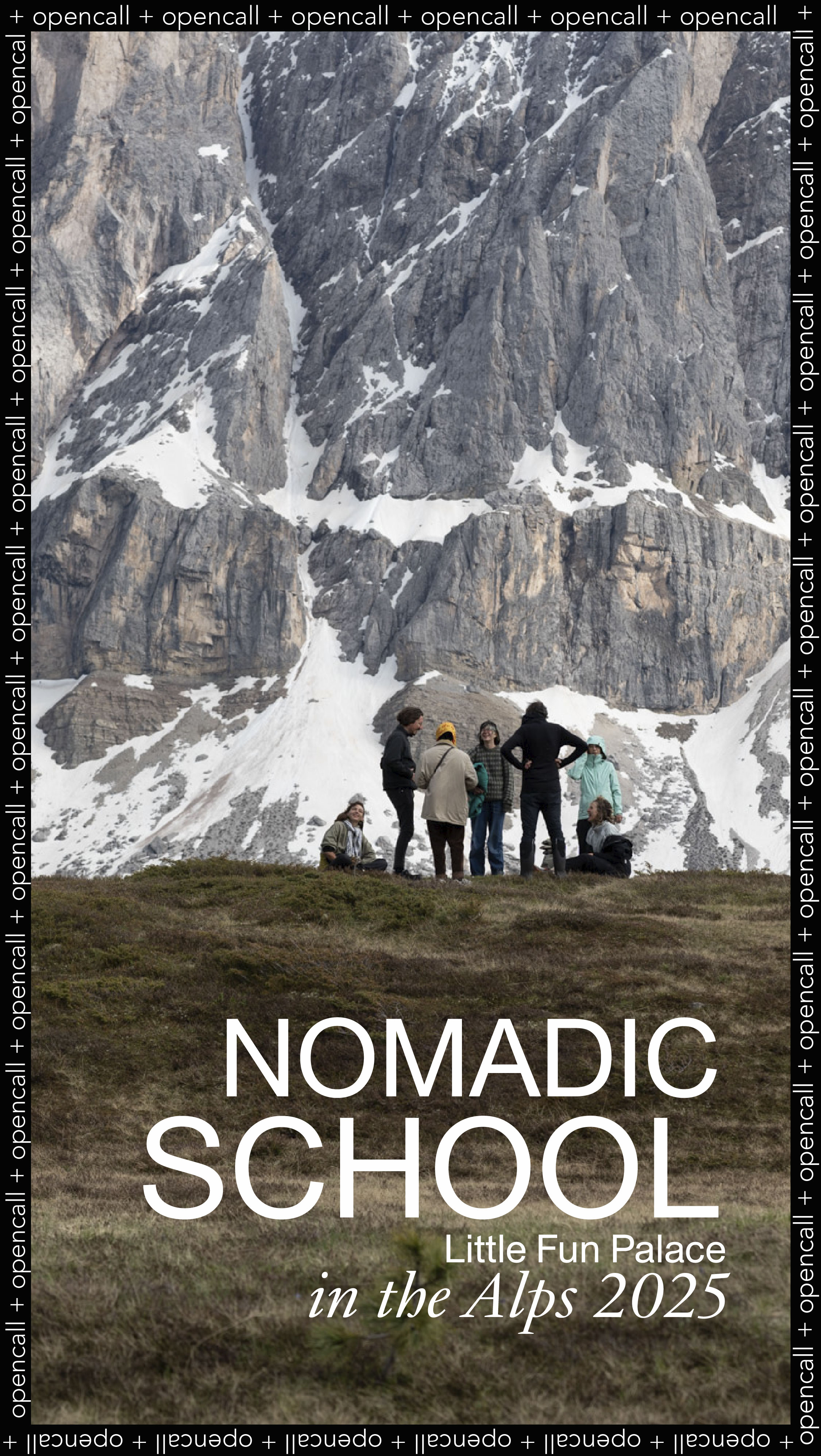content
Nomadic School is an alternative mentorship programme rooted in the Alps and artistic practice. Started in 2020, the school emerged around the Little Fun Palace trailer, nomadic and flexible architecture inspired by architect Cedric Price and filmmaker Joan Littlewood's Fun Palace.
Created by OHT with the intention of fostering exchange among people and bridging the representational distance cultivated by art institutions, over the years Little Fun Palace has been lost in the landscape, giving rise to he Nomadic School and its interaction with the alpine territory. The nomadism of the caravan has become a geographical, artistic, and sentimental approach, capable of continually reinventing its models to foster a free, active, and interrelated environment of artistic exchange.
A central concept to both the school and the book is the notion of spatial-creation — how performative practices create space, both in the architecture of theatres and beyond the theatre as institution — as well as the intersection of disciplines that bridges artistic practices with environmentally-oriented social movements. We actively question what happens when performance is taken outside of closed, institutional spaces, and what could happen when uncontrolled and dynamic environments become factors or participants in the development of performative practices, as well as in other artistic areas.
mentors
born 1984 in Kaunas, Lithuania. Lives and works in London, UK and Vilnius, Lithuania. Lapelytė’s practice is rooted in music, flirts with pop culture, gender stereotypes and nostalgia. Her works engage trained and untrained performers, often in an act of singing that takes the form of a collective and affective event that questions vulnerability and silencing. In 2019, her work Sun & Sea (Marina), made together with Vaiva Grainytè and Rugilè Barzdžiukaitè, curated by Lucia Pietroiusti, won the Golden Lion award at the Venice Biennale. In 2020 she received the national art and culture prize in Lithuania. Lapelytè holds a BA in classical violin (2006) and Sound Arts (2009), MA in Sculpture, London (2013).
growing up partly in rural northern England and partly in rural Greece, she made her artistic base in Athens after completing her dance training in London. She collaborates in interdisciplinary projects between Europe and the UK, often working with musicians, filmmakers, and visual artists on the creation of performance works that cultivate the body’s intuitive intelligence to create states in which to dream new ways of being in the world. Themes of current projects she is involved in include ritual theatre, erotic ecology, experimental polyphony, and lamentation. In 2023, she won the North East Emerging Artist Prize for her audiovisual installation Timekeeping.
> Kris Krois (designer and facilitator for social-ecological transformation)
teaches/researches in the transdisciplinary and practice-based Master in Eco-Social Design at the Free University of Bozen–Bolzano. Together with students and teachers/researchers as well as with partners from neighbourhoods, agricultures, sciences and activism, he is co-creating design practices, tools and structures that contribute to social-ecological transformations towards more solidary and sustainable modes of living and production. Since 2013 he is organising the annual conference By Design or by Disaster. He is part of KAUZ-Laboratory for Climate Justice, Work and Future, and co-founder of the New European Bauhaus of the Mountains and Climate Action South Tyrol.
> Beatrice Citterio (eco-social designer and researcher, ex Nomadic)
specializing in design for landscape and cultural heritage. She explores territorial modification and land management through diverse media, including geo-referenced mapping, fieldwork, photography, and archival research. Currently, she is examining territorial transformations in the lead-up to the 2026 Winter Olympic Games through a multidisciplinary lens, with a focus on diachronic comparisons and the use of language. Her first major outcome is Precious Games: Observatory on the 2026 Milano-Cortina Winter Olympic Games, a self-produced, tabloid-style fanzine that investigates the local and trans-regional dynamics of the Games.
participants
production history
from 26.VIII to 30.VIII.20 > Mountain Bondone, natural biotope, Trentino > a.s.l. 1600 > I Nomadic School
from 23.VIII to 29.VIII.21 > Mountain Bondone, natural biotope, Trentino > a.s.l. 1600 > II Nomadic School
from 25.VI to 03.VII.22 > Vajolet’s towers, Trentino > a.s.l. 2243 > III Nomadic School
from 15.VI to 26.VI.23 > Adamello Brenta Natural Park, Trentino > a.s.l. 1860 > IV Nomadic School
from 02.VI to 14.VI.24 > Sas de Pütia, Alto Adige / Südtirol > a.s.l. 2006 > IV Nomadic School
number of editions
6
